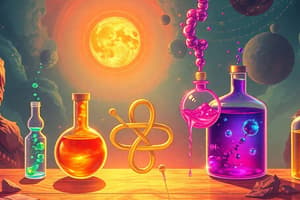Podcast
Questions and Answers
What is the definition of stoichiometry?
What is the definition of stoichiometry?
The study of the quantitative relationships between reactants and products in chemical reactions.
What is the purpose of the mole ratio in stoichiometry?
What is the purpose of the mole ratio in stoichiometry?
To determine the amount of reactants required or products formed in a reaction.
What is a limiting reagent in a chemical reaction?
What is a limiting reagent in a chemical reaction?
The reactant that is completely consumed in a reaction, limiting the amount of product formed.
What is the percentage of the theoretical yield that is actually obtained in a reaction?
What is the percentage of the theoretical yield that is actually obtained in a reaction?
How do you convert moles to mass in stoichiometric calculations?
How do you convert moles to mass in stoichiometric calculations?
What is the purpose of empirical formula calculations in stoichiometry?
What is the purpose of empirical formula calculations in stoichiometry?
What is the importance of stoichiometry in chemistry and chemical engineering?
What is the importance of stoichiometry in chemistry and chemical engineering?
What are some of the fields that utilize stoichiometry?
What are some of the fields that utilize stoichiometry?
Flashcards are hidden until you start studying
Study Notes
Stoichiometry
Definition Stoichiometry is the study of the quantitative relationships between reactants and products in chemical reactions.
Key Concepts
Mole Ratio
- The ratio of the number of moles of one substance to the number of moles of another substance in a chemical reaction.
- Used to determine the amount of reactants required or products formed in a reaction.
Limiting Reagent
- The reactant that is completely consumed in a reaction, limiting the amount of product formed.
- Identified by calculating the number of moles of each reactant and determining which one is used up first.
Excess Reagent
- The reactant that is not completely consumed in a reaction, remaining in excess after the reaction is complete.
Percent Yield
- The percentage of the theoretical yield that is actually obtained in a reaction.
- Calculated by dividing the actual yield by the theoretical yield and multiplying by 100.
Stoichiometric Calculations
Mole-Mass Conversions
- Moles to mass: multiply moles by molar mass
- Mass to moles: divide mass by molar mass
Empirical Formula Calculations
- Determine the mole ratio of elements in a compound
- Use the mole ratio to write the empirical formula
Reaction Stoichiometry
- Calculate the number of moles of reactants required or products formed
- Use mole ratios to determine the amount of reactants required or products formed
Importance of Stoichiometry
- Essential in chemistry and chemical engineering for predicting reaction outcomes and optimizing reaction conditions.
- Used in a wide range of applications, including pharmaceuticals, materials science, and environmental science.
Stoichiometry
Definition
- Study of quantitative relationships between reactants and products in chemical reactions.
Key Concepts
Mole Ratio
- Ratio of moles of one substance to moles of another in a chemical reaction.
- Used to determine reactants required or products formed in a reaction.
Limiting Reagent
- Reactant completely consumed in a reaction, limiting product formed.
- Identified by calculating moles of each reactant and determining which one is used up first.
Excess Reagent
- Reactant not completely consumed in a reaction, remaining in excess after reaction.
Percent Yield
- Percentage of theoretical yield actually obtained in a reaction.
- Calculated by dividing actual yield by theoretical yield and multiplying by 100.
Stoichiometric Calculations
Mole-Mass Conversions
- Moles to mass: multiply moles by molar mass.
- Mass to moles: divide mass by molar mass.
Empirical Formula Calculations
- Determine mole ratio of elements in a compound.
- Use mole ratio to write empirical formula.
Reaction Stoichiometry
- Calculate number of moles of reactants required or products formed.
- Use mole ratios to determine amount of reactants required or products formed.
Importance of Stoichiometry
- Essential in chemistry and chemical engineering for predicting reaction outcomes and optimizing reaction conditions.
- Used in applications such as pharmaceuticals, materials science, and environmental science.
Studying That Suits You
Use AI to generate personalized quizzes and flashcards to suit your learning preferences.




